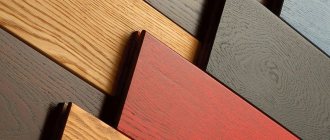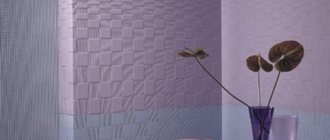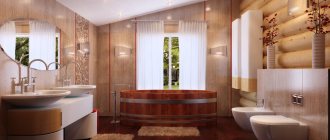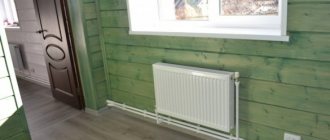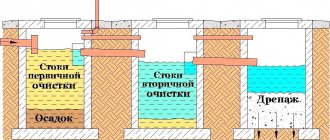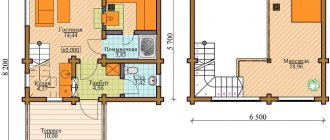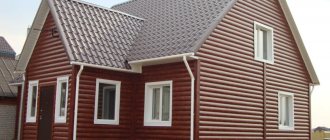Issues discussed in the material:
- Types of swimming pools for a private home
- Advantages and disadvantages of a swimming pool inside a private house
- Pros and cons of a stationary pool in the courtyard of a private house
- Optimal sizes of pools
- Choosing a pool shape
- Swimming pool design in a private house
- Types of pool water
- Technical equipment for a swimming pool in a private house
- Swimming pool maintenance in a private home
- The cost of building and maintaining a swimming pool in a private house
There are hardly people who would refuse such a luxury as a swimming pool in a private home. And if there are such people, they will certainly be in the minority. In fact, such a solution has a lot of advantages: in the heat you can splash in cool water without leaving the cash register, constantly keep yourself in good physical shape, and simply relax after a busy day at work.
However, not everything is as simple as many would like. It’s not enough to decide on the size and shape of the pool, its design and location. There are a significant number of nuances that should be taken into account when constructing this zone in a country house or on the site in front of it. You can’t make a mistake even in the smallest things - otherwise the place for relaxation will turn into a complete headache.
Types of swimming pools for a private home
Are you planning to install a swimming pool in your private home? You will have a choice: inflatable, frame or stationary. They differ in cost and ease of use. In addition, there are design features. Each type has its own pros and cons. The classic solution is to equip a stationary pool, since other models simply copy its functions.
- Inflatable outdoor pool in a private house
If your budget is limited, then it is better to install just such a model. However, you should not expect that the inflatable pool will last long, since it is not reliable enough. Despite this, you can have a great time swimming in it. The walls and bottom of the bowl are made of heavy-duty material. All you need to do is pump air into the free cavity. This model can withstand high loads, but if you handle the inflatable pool carelessly, it will break.
- Frame
Many owners of private houses choose a frame pool. Its main advantage is that the structure can be assembled in the spring and disassembled at the end of summer. The cost of a practical frame pool is low when compared with stationary models.
- Stationary swimming pool in a private house
Before you start building a pool inside a cottage or on a site, you should develop a project and choose a layout. The cost of stationary structures is high, but such a pool will last a long time and looks presentable. You can choose any design by studying photos of swimming pools in a private house. Are you planning to buy a cottage? You can choose an option where a permanent pool is already equipped.
Let's take a closer look at the stationary models - open and closed - and find out what advantages and disadvantages they have.
Which lumber to choose and how to calculate its quantity?
High humidity and water pressure impose strict requirements on the quality of timber and pool boards. The best moisture-resistant breeds available are:
- larch;
- pine;
- spruce.
The recommended board thickness is 5 cm. To save money, many use unedged material.
A structure made from such material is not beautiful, but it performs its function perfectly. High-quality edged boards look neater and the siding will be stronger.
Reference! Old wooden pallets are an excellent material for the frame of a pool, they make strong and even sides.
How to calculate how much material you need:
- measure the perimeter of the pool;
- calculate the number of boards in one horizontal row;
- multiply by the number of rows in height.
You will also need vertical stands. They are made from timber with a cross section of 5 x 10 cm:
- 4 columns are installed in the corners of the pool;
- a few more along the lines of the walls, 1-2 m from each other;
- The height of the racks is calculated taking into account digging into the ground 50 cm.
When cutting and adjusting workpieces to length, losses of lumber occur, so the resulting amount is rounded up.
Small elements of a wooden frame, for example, sides, thresholds, etc. made from aspen. It is not very durable, but is almost not subject to rotting.
Advantages and disadvantages of a swimming pool inside a private house
Just imagine: it’s winter and a blizzard outside, and you are swimming in a pool with warm water, which is located inside the house. Or it’s hot outside, and your whole family is relaxing by an artificial pond.
A swimming pool has health benefits and helps relieve stress. If you don't like fitness clubs and working out until exhaustion, just swim regularly at home. This will allow you to relax and improve muscle tone.
Are there children in the family? Now you don't need to go to the river. Children will be able to splash around in the pool with a shallow water area. Does your son or daughter go swimming? You don't have to take your kids to a public pool; they can train at home.
Two swimming lanes will benefit both parents and children. Swimming relaxes a person and relieves stress after a hard day. A home pool will give the whole family harmony and peace.
What are the disadvantages of having a pool on the street or in a private home?
If you decide to equip the pool indoors, it will be comfortable to use the pool, but you will have to spend a large sum. Construction technology must not be violated, otherwise the foundation of the house will become flooded and the building will collapse. It is necessary to determine the type of soil in advance, because the soil must withstand high loads.
In addition, if you have a swimming pool in a private house, you will have to waterproof it so that humid air and mold do not penetrate into neighboring rooms.
You also need to install lighting and think about how you will heat the pool. To have more natural light in the room, make panoramic windows. They create a feeling of unity with nature. However, in this case, heat losses will increase: additional radiators will have to be installed.
Note!
Since air conditioning, lighting and a heating system will be installed in the pool, the costs of its maintenance will be high.
The design of a swimming pool in a private house must be developed before construction work begins. If the cottage is half built, and you decide to equip swimming lanes, making changes to the project will be problematic. In this case, it is recommended to locate the pool in the extension.
Rules for stationary structures
Installing a permanent pool at your dacha implies a significant increase in material and time costs. But it is the most durable.
Main differences:
Design documentation, drawings and estimates for construction work and equipment are required.- It is necessary to dig a pit, install reinforcement, pour concrete and connect communications.
- We need finishing of the pool walls, installation and adjustment of complex equipment.
Attention! It is better to entrust such work to highly qualified specialists.
Pros and cons of a stationary pool in the courtyard of a private house
Placing a pool on the site is more profitable than inside the cottage. In this case, the structure does not have a negative impact on the residential building: it will not be humid inside, and there will be no need to install a ventilation system. Heating and lighting costs will not increase.
What other advantages does a stationary pool have on site:
- you can swim any time you want, except perhaps in winter;
- your family will relax near the water in hot weather;
- small children will enjoy swimming;
- a stationary outdoor pool is an opportunity to have fun;
- when it’s far away from a river or lake, you can quickly cool off in the pool;
- If the pool is kept clean, it will beautify the area.
What are the disadvantages of a stationary structure?
To maintain an outdoor pool, you will have to spend a lot of money and effort. It is necessary to regularly clean the bottom and walls, replace the water, and add chemicals to prevent the water from blooming. However, they should be used with caution, since the “chemistry” has a detrimental effect on health.
You need to think about where you will drain the water. If chemicals are used, you should not water your lawn or garden with water. However, it will have to be changed, which means that a place for draining water should be equipped in advance.
For the winter, such a pool will have to be mothballed. It needs to be cleaned, the water drained, the filters and heating system removed, the drains closed, and filled with water and a preservative. This procedure will require time and labor.
The outdoor pool is inferior in terms of comfort to the swimming lanes in the cottage. But you will notice the difference only if you live outside the city all year round and will not be able to swim in autumn and winter.
But when you have a summer house or cottage, it is recommended to choose an outdoor pool. Its cost is low, but adults and children will feel comfortable swimming in such a pool.
How to make a frame for a swimming pool with your own hands from wood
If only the frame is planned to be made of wood, the boards can be fastened with ordinary self-tapping screws.
The construction of a pool of wood and timber with your own hands is carried out according to the following step-by-step instructions.
- Level the area under the pond and compact the soil. If they want to bury the pool bowl into the ground, first they dig a pit of the required size, fill the bottom with a layer of crushed stone and sand and fill it with concrete. It's more expensive.
- Mark the area. At the corners of the perimeter, holes are made for the racks to a depth of at least 50 cm.
- The ends of the racks, which are immersed underground, are treated with bitumen or resin. They are immersed in holes and covered with rubble.
- The corner posts are aligned and connected with a cord. The remaining racks are installed and fixed along the cord.
- Water inlet and outlet pipes are dug in at a predetermined location.
- Boards for sides are treated with antiseptics and drying oil. They are fixed to the racks horizontally, with flooring, but not tightly, with a gap of up to 1 cm. Instead of boards, you can use waterproof plywood.
- From the outside, the intermediate elements are reinforced with spacers.
- The pool cover is cut out according to the dimensions of the frame. The film can be glued or welded if necessary. Place the film in the pool bowl, extending the edge beyond the edge of the side by at least 20 cm.
- Install drain holes. The outlet pipe is connected to the sewer system, and the supply pipe is connected to the water supply in the house.
- Fill the pool with water to at least 20 cm to check the effectiveness of communication and waterproofing. The film expands under the weight of water.
- Install stiffeners, belts, and other fasteners.
If necessary, the outside walls of the pool can be insulated and then sealed again with clapboard or boards.
Optimal sizes of pools
What size should a swimming pool be in a private home? It is impossible to answer this question unambiguously. If the swimming lanes are long, swimming training can be done. However, you will have to spend a large sum to build a large bowl, install all the necessary equipment, and install heating. For the sake of large dimensions, you will have to sacrifice the area of the territory.
The best option is to make a bowl measuring 8 by 4 by 1.4 meters. You will be able to swim comfortably along a path that is 8 meters long, and the depth of the pool will be 120–140 cm. Due to the fact that the pool is wide (4 meters), it will have ideal proportions. By the way, this is the width that allows two people to swim side by side without touching each other.
What size should a swimming pool be in a private home if you are just going to swim in it? A structure of 4 by 5 meters with a depth of 120 cm is sufficient.
Approximate turnkey cost
| Pool design and size | Price from, rub | The cost of preparatory and installation work is based on RUB 3,000/m2 | Total, rub |
| Inflatable pool Bestway, 91*457 cm | 12600 | 45000 | 57600 |
| Frame pool Bestway, 122*457*457 cm | 33000 | 45000 | 78000 |
| Frost-resistant pool Gibraltar J-4000 4.6x1.35m | 172000 | 45000 | 217000 |
Choosing a pool shape
The shape of the pool depends on your wishes. It is not at all necessary to choose a standard rectangular design. The bowl can have curved contours to best fit into the landscape.
If the pool is non-standard, its cost will increase. However, it will fit perfectly into the space allocated for it. When choosing a form, you should take into account the area of the territory, the features of the site, the relief and the layout.
Which pools are most popular:
- corner bowls (made of concrete);
- with rounded corners (plastic);
- with one- or two-sided Roman steps (made of concrete or plastic);
- oval-shaped (made of concrete or metal);
- in the form of a bean (made of concrete);
- crescent-shaped (made of concrete);
- in the form of a circle (made of metal);
- in the shape of a figure eight (made of metal).
Swimming pool design in a private house
If you are planning to place a swimming pool on your property or in your house, you need to choose its design, as well as decide on additional options.
- Waterfalls
The best technique to add functionality. You can make the pressure more or less so that the waterfall resembles a spring or a turbulent stream.
- Bubbling fountains, water streams
In appearance, they resemble small geysers installed in shallow water areas. The bubbling water attracts children and looks aesthetically pleasing. By the way, the cost of such an installation is not too high.
- Unusual lighting
Install LEDs with shade mixing function to brighten up your pool. You can independently adjust the speed and sequence of color changes. Such lighting will attract the attention of everyone who is near the pool.
- Water slide
This solution will make it possible to create a kind of mini-water park. Your family will definitely not remain indifferent. A water slide can be either large or small.
- SPA zone and hydromassage
SPA zones can be of any size, shape or shade. They will become a real decoration of your pool. And hydromassage will help relieve tension throughout the body.
- Artificial flow
You can conduct swimming training even in a medium-sized pool. Thanks to the counterflow, classes will be as effective as possible.
Pool water type
To equip a swimming pool in a private home, you need to decide what type of water to fill it with.
- Fresh water (disinfectant – chlorine). This option is inexpensive and accessible, and is chosen by many cottage owners.
- Fresh water (disinfectant - oxygen). In this case, the risk of skin and eye allergies is minimal, since virtually no chlorine is used.
- Fresh water (disinfectants – silver and copper). The main advantage is that there will be no chlorine in the pool at all. There is only one parameter you need to monitor - acidity.
- Water with salt. In this case, you will have to install an electrolyzer. The water will contain from 4 to 6 percent salts. You will be able to use a minimum of chemicals. This water has a beneficial effect on human skin.
Technical equipment for a swimming pool in a private house
For pool maintenance, you can invite professionals working with suppliers of special equipment. But you also need to figure out how to choose the necessary components.
- Filter pump
This unit is designed in such a way that water is purified from contaminants by passing through sand. Filtration allows you to eliminate hairs, dust, organic and mineral inclusions, and other contaminants. If the bowl is small, you can use any filter material.
Without a pump, the system will not work, since it pumps water, preventing it from stagnating. For a mini-pool, choose a combined filter and pump. When purchasing, find out what the pump's performance is, as well as the volume of water it can pump.
If the pool is large enough, you should purchase the filter and pump separately. Their installation cost is higher, but productivity will also increase.
- Pipes, skimmers, and nozzles
There are a huge number of different models on sale, which can be purchased separately. However, most companies involved in the installation of swimming pools work with wholesale companies or supply the equipment themselves.
The stationary skimmer is made in the form of a small container with a mesh. It is necessary to keep water at the required level. The mesh filters debris, preventing it from reaching the surface of the water.
If the pool is stationary, the skimmer is built into the wall and connected to a diode drain. The more popular the brand and the more expensive the material, the higher the price of the device. The most expensive skimmer is made of stainless steel; this installation lasts a long time, looks aesthetically pleasing and retains its decorative properties throughout its entire service life. A plastic skimmer will work for no more than 10 years, but will quickly lose its visual appeal.
A frame pool will require a hanging skimmer. Its operating principle is identical to the previous model, but it is attached differently.
- Disinfection
If you want to build or buy a private house with a swimming pool, be prepared for the fact that the water will have to be disinfected regularly. How to prevent bacteria from growing in a pool? There are many solutions: add chlorine to the water, do ozonation, ionization or ultraviolet disinfection.
If you choose to use reagents, you will need to monitor the pH of the water and select the appropriate dose of chlorine. No matter what chemical you use, the principle of action is the same. How to find out pH? Using the sensor on the control panel.
You can also purchase an ionizer that disinfects water using copper and silver ions. These installations are quite effective and do not cause allergic reactions in humans. It is allowed to use ionizers at home, as they are not dangerous for small children.
- Heating
How to build a swimming pool in a private house, in which you can swim even in winter? To do this, it is necessary to equip the heating. A heater will be required as well as a heat exchanger.
Is your cottage heated using central heating or connected to a boiler room? Then hot water will be supplied to the heat exchanger. For large estates, sometimes a separate boiler room is made, and a complex with a bathhouse and a swimming pool is attached to it.
There are several ways to organize heating of an artificial reservoir. The most popular solution is a heat pump. Its maintenance will be cheaper than an electric heater.
- Ventilation in the swimming pool of a private house
To ensure that the room where the tank is located has an optimal microclimate and moisture does not penetrate into the living rooms, it is necessary to install a ventilation system.
There are 3 types of such equipment. Most often, forced supply and exhaust ventilation is installed. It has high performance and can also connect other devices.
If highly efficient ventilation is required, choose supply and exhaust ventilation with air dehumidification. The dehumidifier can be wall-mounted (mounted in the room where the bowl is located), as well as cassette or ducted (mounted in the utility room).
The maximum efficiency is for combined ventilation, combining dehumidification and air conditioning. Supply and exhaust ventilation operates normally. However, if the load increases, the dehumidifier and air conditioner turn on. They start automatically, the ECU is guided by the selected humidity parameters. In winter, optimal humidity is maintained thanks to the dehumidifier, and ventilation ensures effective air exchange.
- Lighting
The ideal solution for a swimming pool in a private house is to install panoramic glazing. Sunlight penetrates through such windows. However, in the evening artificial lighting will be required. Ultra-modern lighting is highly reliable; the room will be as bright as day. If the pool is located in the basement, the heating must be powerful enough.
- Control system
How to check if the equipment is functioning normally? To do this, equipment indicators are monitored: heating temperature, disinfection regulation, pump and filter control.
Sensors are purchased separately. Then they are connected into an electrical circuit along with the equipment used. Based on the obtained indicators, you can monitor whether the equipment is functioning normally.
Important! If you make a mistake when connecting an electrical circuit, you may get an electric shock and the equipment will also be damaged.
It is necessary to lay the wires correctly without violating electrical safety rules. Each device made of metal is grounded, all cables are insulated. The pool is equipped with a potential equalization system. Otherwise, you may get an electric shock while swimming.
When creating a project, it is important to divide the space, highlighting the areas where sockets and wires will be located. The equipment must be located in a special room, and an automatic shutdown system will also need to be installed.
While the electrician is working, make sure that he equips electrical protection, this will prevent electric shock while sailing.
Making a sand filter
Making a filter
This is a very important element of the entire system, which will remove organic residues and other debris from the water. If you don’t do this, then you will have to change the water very often, which will cost a pretty penny. To make it you will need:
- plastic barrel 100 l;
- fittings for HDPE pipes;
- cartridge from the filter flask;
- low-power centrifugal pump (it’s good if it’s self-priming);
- clean sand.
In order for everything to function, it is necessary that the barrel has a lid that will close tightly. Stepping back 10 cm from the top of the container, make a hole for the thread of the fitting. The rubber gasket is put on and the thread is inserted into the prepared place. On the other side, another rubber gasket is put on and a metal nut is tightened. In exactly the same way, you need to organize the exit at the bottom. The filter cartridge is connected to the thread of the lower fitting from the inside. It is important to close its second end with a lid of suitable diameter. Sand is poured inside; a little more than half the container is needed. Hoses through which circulation will be carried out are connected to the adapters. A pump is installed in the lower hose for the gap.
The system will function as follows: due to the fact that the container will be below the water level in the pool, the liquid will flow into the barrel by gravity. Passing through a layer of sand, it will be cleaned. Purified water will flow through the mesh of the filter cartridge into the hose that goes to the pump. The motor, in turn, will push it back into the pool.
Working principle of a sand filter
You can make an interesting design, in the form of a pot. To do this you will need natural stone or pebbles from the river. From them the elevation is laid out. A hose is placed inside through which water is supplied from the filter. As it approaches the slide, it will flow into the pool in the form of a waterfall.
There is another option that will be a little more difficult to manufacture, but the performance will be excellent. In addition, it will be possible to implement an automatic filter cleaning system. The components you will need are:
- hydraulic accumulator tank;
- fittings and pipes made of polypropylene;
- soldering iron for pipes;
- pipe cutters;
- drill and metal drill bit;
- flask cartridge;
- adjustable wrench;
- pump;
- 4 ball valves.
You need to do the following:
- The rubber membrane that is inside is removed from the metal tank. To do this, unscrew all the bolts that hold the flange.
- A little higher than this hole, another hole is drilled. Its diameter must be made such that the thread from the MRN can fit through.
- One brass nut is screwed onto the MRN until it stops, a rubber gasket is put on and the thread is inserted into the prepared hole. On the other side, another gasket is put on and secured with a second nut.
- A pipe of approximately 15 cm is soldered to the fitting with an American-type adapter.
- A filter cartridge is placed on a piece of pipe.
- The finished structure is screwed to the threaded connection that has been installed.
- The hydraulic accumulator is installed vertically and sand is poured into the middle. This is done a little more than halfway.
- A fine metal mesh is placed inside, which will serve as a limiter for the natural filter.
- The flange is installed in place.
- A tee is screwed to the thread that comes out of the flange.
- Two taps are installed in the tee. One of them will be for supply, the second will be used if automatic filter cleaning is necessary.
- A tee is soldered into the MRN, to which two more taps are connected.
- A bypass jumper must be made between the inlet and outlet openings.
- A pump is connected to the metal tee, which is located on the thread of the flange, which will supply it. A hose is connected to the second tap on the metal tee, through which debris will flow out during cleaning.
- A pipe for draining clean water is connected to one of the taps on a plastic tee. A bypass is connected to the second tap.
The essence of the system is as follows: water is sucked by a pump from the pool and supplied under pressure to the tank, passing through the sand and filter cartridge, it is returned to the bathing tank. If automatic cleaning is required, then the flow must be redirected. To do this, open a tap through which the debris flows out through a hose (it is located on the tee, which is screwed to the flange). The tap on the outgoing pipe is closed, the supply tap is also closed, but the one on the bypass opens. Thus, the water begins to move first through the filter cartridge, then through the sand. The metal mesh that serves as a fence will prevent it from being washed out. But the dirt that has accumulated above the mesh will flow away freely.
In the following video you will find instructions for making a homemade pool filter:
Swimming pool maintenance in a private home
Any pool needs to be maintained. No matter how big or small it is, it will need to be serviced regularly. Many people think that it will be enough to keep things clean and remove accumulated garbage.
In reality, maintaining a pool is much more difficult. The water in it is “alive”, it interacts with the outside world and influences the people swimming. What is proper maintenance?
- One-time events
Cleaning the pool bowl . This process is technologically complex. To clean the tank, you will need special equipment: guns designed for applying foam; rotary machines, they remove pollution from the bottom; pumps that pump out water.
In order not to spend a large sum on unplanned draining of a huge amount of water and cleaning the pool, you need timely care for the bowl. However, if such a need has already arisen, you should contact a specialized company. Professionals will remove lime deposits; they will not need to drain water or use chemicals.
Treatment of the bowl against algae . This procedure is needed when the tank is located outside. Agree, you don’t want to swim in a pool if the water in it has bloomed. To prevent this, after cleaning the bowl, coat it with a product that prevents algae from growing. This activity must be carried out every time before adding new water to the tank.
Preservation of the pool and preparing it for use . When you swim in an artificial reservoir only in the summer, launching and conservation should be carried out in spring and autumn, respectively. What needs to be done at the end of summer? We clean it, apply a protective coating, submerge expansion joints in the water (when it freezes), and cover the pool with a protective cover.
Equipment should also be preserved. Before starting the system, we clean the bowl and perform preparatory procedures.
- Regular Maintenance
Filter care. To ensure that the water is clean and you can swim, you need to monitor the filter elements and change them on time. Filters often work continuously, overloaded, even when you are not using the pool.
If the filters become dirty, the water will begin to bloom and become cloudy, and an unpleasant odor will appear. Since dirt continuously accumulates in the filter elements, they must be washed periodically. Otherwise, the water purification process will be ineffective.
Checking water quality . To ensure high water quality, check the acidity level and adjust it if necessary. Monitor free chlorine levels.
Testers are used to determine these parameters. Once the necessary data is obtained, you can set up an automatic dosing system. You can add alkali or acid, as well as a disinfectant, to the water yourself.
Tips for care and use
The pool needs to be disassembled for the winter.
A pool made of boards needs maintenance.
- You should not leave the pond filled during the cold season. If in winter the temperature drops much below zero, it is better to disassemble the entire structure.
- Wooden elements should be periodically treated with antiseptics and soaked in drying oil.
- You need to ensure that when you empty the bowl, the water completely leaves the reservoir.
A wooden pool is a very unusual solution. Unlike a concrete structure, it can be made and installed independently, but it does not last long and requires maintenance.

